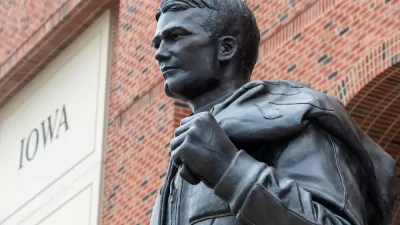This article from Governing looks at the role of higher education and medical facilities in keeping urban areas alive.
"In an era when technological know-how and innovation have become prime economic drivers, 'eds and meds' have become indispensable anchors of urban growth. 'In many respects,' a report by CEOs for Cities and the Initiative for a Competitive Inner City commented a few years ago, 'the bell towers of academic institutions have replaced smokestacks as the drivers of the American urban economy.'"
"Yet until relatively recently, most universities and the cities surrounding them went about their business without taking full stock of what each meant to the other. Many local and state government leaders, notes Temple University political scientist Carolyn Adams, "don't see these institutions as having an economic development function much beyond employment and land development." For their part, hospitals and academic institutions aren't accustomed to thinking of themselves as de facto economic bigwigs or pondering the responsibilities that go along with that status; for many, the prevailing attitude toward the communities that host them has essentially been, 'You should just thank your lucky stars we're here.'"
"And to a degree, of course, they're right. A 1999 Brookings Institution report by University of Pennsylvania historian Ira Harkavy and Harmon Zuckerman - now the chief planner for Douglas County, Nevada - found that in the 20 largest U.S. cities, "eds and meds" accounted for 35 percent of the workforce employed by the top 10 private employers; in many cities, a university or medical system was the largest private employer, and in four of them - Washington D.C., Philadelphia, San Diego and Baltimore - medical systems and universities generated more than half the jobs among the 10 largest private employers."
FULL STORY: Eds, Meds and Urban Revival

Alabama: Trump Terminates Settlements for Black Communities Harmed By Raw Sewage
Trump deemed the landmark civil rights agreement “illegal DEI and environmental justice policy.”

Study: Maui’s Plan to Convert Vacation Rentals to Long-Term Housing Could Cause Nearly $1 Billion Economic Loss
The plan would reduce visitor accommodation by 25% resulting in 1,900 jobs lost.

Why Should We Subsidize Public Transportation?
Many public transit agencies face financial stress due to rising costs, declining fare revenue, and declining subsidies. Transit advocates must provide a strong business case for increasing public transit funding.

Paris Bike Boom Leads to Steep Drop in Air Pollution
The French city’s air quality has improved dramatically in the past 20 years, coinciding with a growth in cycling.

Why Housing Costs More to Build in California Than in Texas
Hard costs like labor and materials combined with ‘soft’ costs such as permitting make building in the San Francisco Bay Area almost three times as costly as in Texas cities.

San Diego County Sees a Rise in Urban Coyotes
San Diego County experiences a rise in urban coyotes, as sightings become prevalent throughout its urban neighbourhoods and surrounding areas.
Urban Design for Planners 1: Software Tools
This six-course series explores essential urban design concepts using open source software and equips planners with the tools they need to participate fully in the urban design process.
Planning for Universal Design
Learn the tools for implementing Universal Design in planning regulations.
Smith Gee Studio
Alamo Area Metropolitan Planning Organization
City of Santa Clarita
Institute for Housing and Urban Development Studies (IHS)
City of Grandview
Harvard GSD Executive Education
Toledo-Lucas County Plan Commissions
Salt Lake City
NYU Wagner Graduate School of Public Service





























